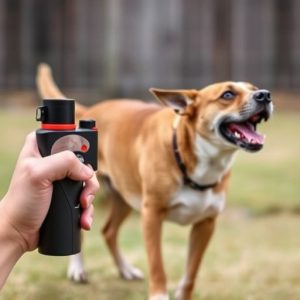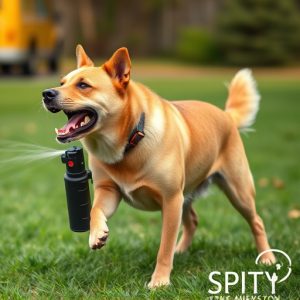Mace Dog Spray Legal Defense: Strategies to Neutralize Charges
Mace dog spray, a non-lethal defense tool for pets, temporarily disables aggressors but requires car…….
Mace dog spray, a non-lethal defense tool for pets, temporarily disables aggressors but requires careful handling due to potential skin irritation. Before using it, understand local laws and follow manufacturer instructions. In case of accidental exposure, immediate water rinsing helps neutralize effects, though veterinary care may still be needed. For legal defenses against charges related to Mace spray, pet owners should gather evidence, consult legal professionals specializing in animal law, and focus on neutralizing the spray on their pet's skin as a justification for reasonable force used. Case studies highlight successful strategies involving prompt action, thorough documentation, expert testimony, and veterinary consultation to achieve favorable outcomes.
In today’s digital era, understanding the legal implications of mace dog spray is crucial for pet owners. This article delves into the science behind mace and its effects on pets, offering practical guidance on building a strong defense. We explore innovative legal strategies to protect owners from unfounded charges, backed by compelling case studies showcasing successful mace spray defenses. Additionally, learn effective techniques to neutralize mace spray on pet skin, ensuring both safety and justice for your furry companion.
- Understanding Mace Dog Spray and Its Legal Implications
- The Science Behind Mace and Its Effects on Pets
- Building a Strong Defense: Legal Strategies for Owners
- Case Studies: Success Stories in Mace Spray Defense
Understanding Mace Dog Spray and Its Legal Implications
Mace dog spray, also known as pepper spray for dogs, is a non-lethal self-defense tool designed to temporarily incapacitate an aggressor. It works by irritating the eyes and respiratory system, causing the target to stumble and become disoriented. However, understanding its legal implications is crucial when considering its use. Each jurisdiction has different regulations regarding the possession, use, and legality of mace dog spray, so it’s essential to check local laws before purchasing or deploying such a device.
When it comes to neutralizing mace spray on pet skin, proper handling is critical. If used incorrectly, it can cause discomfort or even injury to pets. It’s important to follow manufacturer instructions and ensure the spray is designed for safe use on animals. In case of accidental exposure, immediate rinsing with water can help neutralize the effects, although veterinary care might still be necessary depending on the severity of the reaction.
The Science Behind Mace and Its Effects on Pets
Mace dog spray, also known as pepper spray, is a chemical compound designed to temporarily incapacitate an individual by causing irritation and pain in the eyes, nose, and respiratory system. When used against pets, it can have severe effects on their sensitive skin and tissues. The active ingredient in mace spray, capsaicin, is derived from chili peppers and binds to specific receptors in the body, leading to a range of physiological responses.
The impact of neutralizing mace spray on pet skin is crucial. Pets, especially dogs, have a more delicate skin barrier compared to humans, making them susceptible to chemical irritants. When mace spray comes into contact with their skin, it can cause redness, swelling, and even chemical burns. The eyes are particularly vulnerable due to their high concentration of nerve endings. Prompt action is necessary to neutralize the effects, including thorough rinsing with water or using specialized pet-safe decontaminant solutions. This initial step is vital in minimizing discomfort and potential long-term damage for your furry companion.
Building a Strong Defense: Legal Strategies for Owners
When facing legal repercussions after an incident involving dog spray, having a robust defense strategy is paramount for pet owners. The first step in building a strong case is understanding the specific laws and regulations related to animal control and public safety in your jurisdiction. It’s crucial to gather evidence, including any video footage or witness statements, that can support your narrative. For instance, if the use of dog spray was justified due to an aggressive animal, documenting the encounter with clear visuals or eyewitness accounts can help neutralize any allegations against you.
Additionally, consulting with legal professionals specializing in animal law is key. They can guide you on how to navigate the legal process, interpret relevant laws, and present a compelling defense. One effective approach is focusing on the neutralization of Mace spray on your pet’s skin as evidence of reasonable force used during the incident. This strategy, combined with expert testimony and thorough documentation, can significantly strengthen your case and potentially lead to a favorable outcome.
Case Studies: Success Stories in Mace Spray Defense
In the realm of legal defense involving mace dog spray, understanding real-world applications and success stories can offer valuable insights for those facing charges. Case studies illustrate practical strategies that have proven effective in neutralizing Mace spray on pet skin, a common concern when pets are mistakenly exposed or used as a defensive measure. These examples highlight the importance of prompt action, proper documentation, and expert testimony.
For instance, several successful defense cases have focused on demonstrating the lack of malicious intent and the reasonableness of the individual’s actions. In these scenarios, pet owners or handlers were able to provide detailed accounts of the situation, showcasing how they used the spray as a last resort to protect themselves or their animals from perceived threats. Through meticulous care in handling evidence and consulting with veterinary experts, defense attorneys have successfully challenged prosecution claims, ultimately leading to favorable outcomes.
In light of the complex legal landscape surrounding mace dog spray, understanding both its effects on pets and the available defense strategies is paramount. The science behind mace reveals its potential for neutralizing an animal’s skin, but proper context and responsible use are key. Through robust legal defenses, owners can protect their rights while ensuring the well-being of their pets. By studying successful case studies, individuals can navigate this issue with confidence, ultimately promoting a balance between public safety and the humane treatment of animals.


